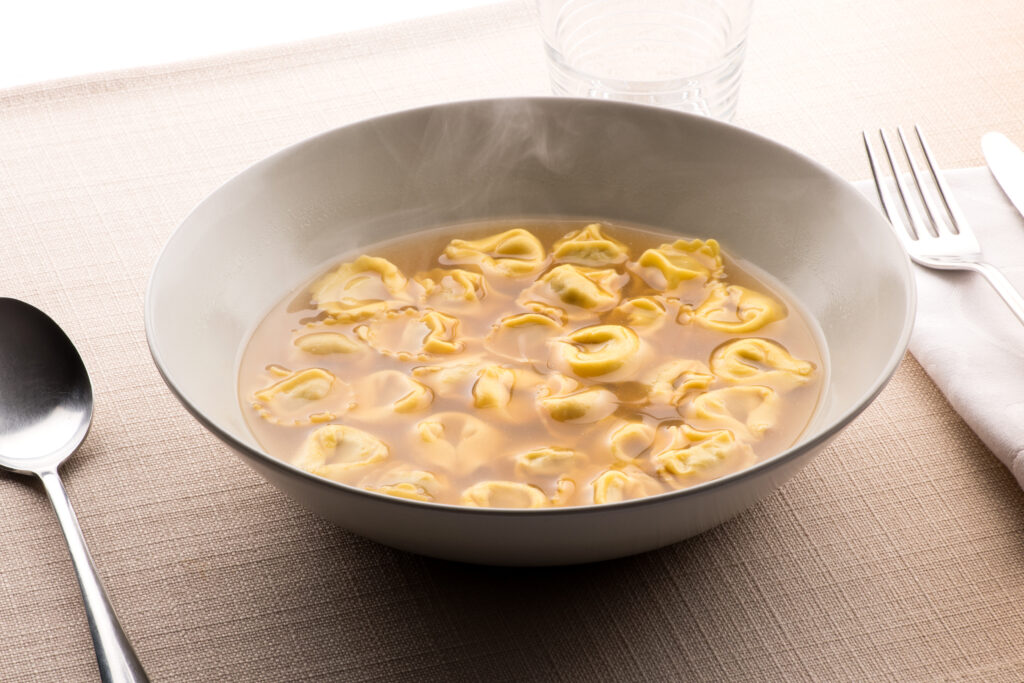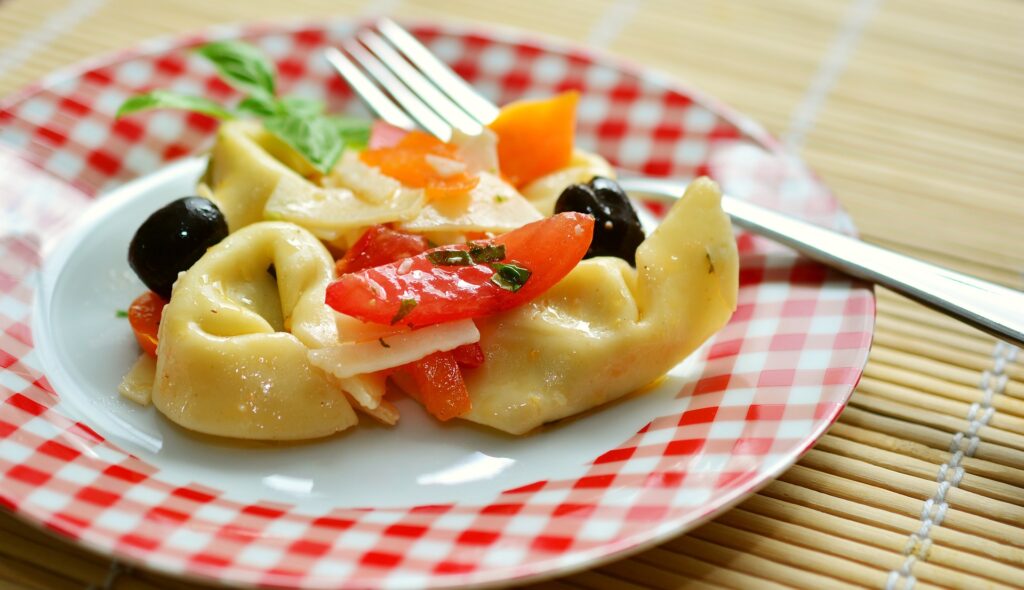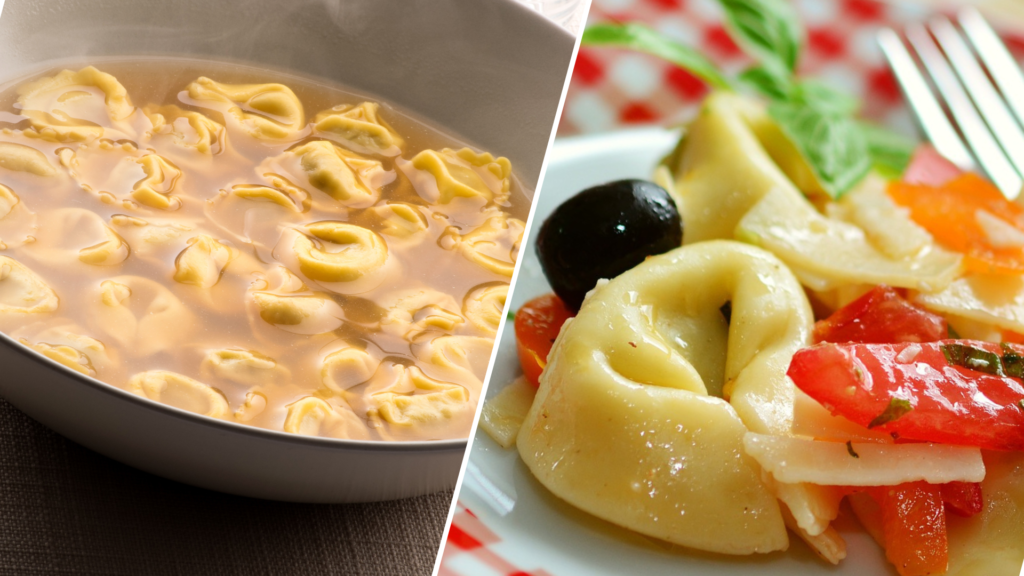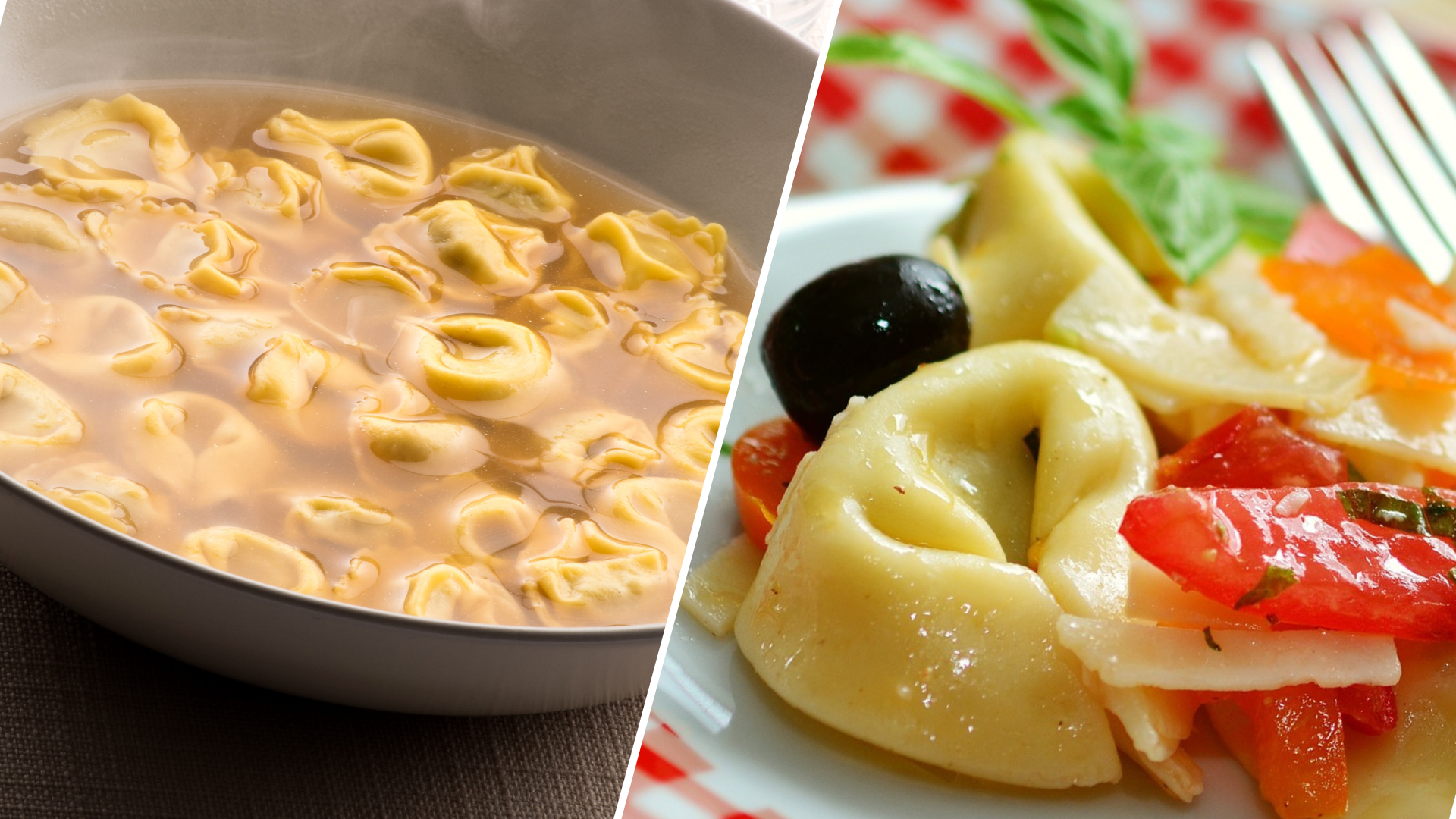Some of the links on this page are affiliate links, which means that Buzzy Kitchen earns commission from purchases made – at absolutely no extra cost to you. Thank you so much for supporting Buzzy Kitchen!
Two types of pasta with very similar names, but what’s the difference between tortellini and tortelloni pasta, really? Which one is bigger? How do you eat or serve them? Where do they originate from?
Let’s delve into the world of North Italian pasta and discover the similarities and differences. Who knows what we’ll find out!
Are Tortellini and Tortelloni the Same Thing?
No, these two types of pasta are not the same thing.
Tortellini and tortelloni are certainly similar, but they have several differences. Despite originating in the same country, the size, creation, filling, cooking methods, and even serving styles are totally different.
Let’s take a closer look and find out why tortellini and tortelloni are definitely not the same thing.
What is Tortellini Pasta?
Tortellini is a type of filled or stuffed pasta that originates from the Emilia-Romagna region of Northern Italy; either from Modena or Bologna, depending on which origin story you believe in. The exact city has been hotly debated, but that seems to be the case for many a traditional food in this day and age.
Traditionally, these wrapped-up pasta parcels were filled with a combination of meats, egg, nutmeg, and cheese, then served in a broth known as capon broth (made from a castrated, force-fed chicken).
The individual pieces are ring-shaped, and there’s quite an interesting story behind that. You can read all about that here.

What is Tortellini Filled With?
Tortellini is usually filled with mostly meat-based ingredients, but these days you can find meat-free, meat-replacement, vegetable, and all sorts of other types of filling.
One example of this is by a brand called Mr. Organic, which offers a Porcini and Mushroom Tortellini. The pasta is made with durum semolina, and is vegan-friendly, non-GMO, preservative-free, wheat-free, soy-free, and egg-free.
There’s also Egg-Free Tortellini with Vegetables by Mr. Organic, which is mustard, celery, egg, peanut, and dairy free.
Barilla, a well-known brand of Italian food products, offers an interesting array of tortellini fillings, too. These include Three Cheese and Ham and Formaggio.
Spinach and Ricotta is another common filling; although, this is usually reserved for tortelloni. We’ll get to that shortly. Epicure Deli-Italia range includes Ricotta and Spinach Tortellini, Beef and Mortadella Tortellini, and Tomato and Basil Tortellini, all of which are completely gluten-free!
So, in short, tortellini are commonly filled with:
- Meat, usually pork or beef
- Cheese, such as ricotta and formaggio
- Leafy greens, such as spinach
How Are You Supposed to Eat Tortellini?
If we’re once again sticking with the traditional theme, tortellini usually come served up in a type of broth or soup. The smaller pieces of pasta require something else around them, to help make the dish more filling and substantial. The type of broth or soup is important because it should enhance and bring out the flavours of the meaty fillings rather than overwhelm it.
Do You Eat Tortellini with a Fork or a Spoon?
Tortellini, when served in broth or soup, should be eaten with a spoon.
The humble spoon is reserved for all things served in a watery liquid, such as broth. If the broth was thicker, more like a pasta sauce, you would then eat the dish with a fork.
There are no real hard and fast rules when it comes to cutlery these days. No one is going to judge you for using the wrong ones when you’re sitting at home and happily eating at your own table. And, in all honesty, everyone in a restaurant is too busy with their own food and conversation, usually, to worry about what kind of fork or spoon you’re using with a particular dish.
What is Tortelloni Pasta?
Although it looks like a larger version of tortellini pasta, tortelloni is actually quite different. It is larger than tortellini in both size and weight, and because of that, it’s stuffed with a larger amount of ingredients. In turn, tortelloni is more of a substantial meal than tortellini. Technically, tortelloni is a “medium sized” pasta.
That’s not the only difference between the two types of stuffed pasta, though.

What is Tortelloni Filled With?
Back in the ‘olden days,’ the smaller tortellini pasta would be filled with meat while the larger tortelloni pasta would be larger and filled with things such as spinach, parsley, egg, nutmeg, other leafy herbs, and ricotta or other cheeses, the latter being the most popular. Walnuts and porcini mushrooms are/were common fillings, too.
These days, the fillings of both types are interchangeable, and you’ll often find combinations of both in supermarkets. Let’s take Tesco as an example. There are the following types of (Tesco branded) tortelloni on sale:
- Spinach and Ricotta
- Chicken and Chorizo
- Sausage and Ham
- Four Cheese
- Cheese and Tomato
- Ham and Cheese
Another brand, La Famiglia Rana, also available at Tesco and other supermarkets, has the following flavours and stuffings:
- Prosciutto and Mozzarella
- Spinach and Ricotta
- Bolognese
- Mushroom and Mascarpone
- Aubergine Parmigiana
- Chicken and Smoked Pancetta
And that’s just one supermarket! Shopping or browsing around in other supermarkets will open up a big world of pasta, I tell ya!
How is Tortelloni Served?
More common in Northern regions of Italy, tortelloni was a common treat served up on Christmas Eve. Some reports say, this is because those following the Catholic faith aren’t allowed consume meat on Christmas Eve. That’s why traditional tortelloni had a meat-free stuffing!
In certain regions of Italy, such as Reggio Emilia, Modena, and Ferrara, tortelloni is stuffed with a blend of amaretti biscuits and pumpkin pulp. It sounds deliciously interesting, don’t you think?
The traditional way of cooking is to boil the pasta first, then fry it before serving in a pan with sage leaves and butter. The pasta is then finished off with a sprinkling of grated parmesan cheese over the top.
What’s the Difference Between Tortellini and Tortelloni?
There are many differences between the two types of stuffed pasta, tortellini and tortelloni, which is why they are two different types and names of pasta. The most obvious difference is, of course, the size, so why don’t we start there?
Tortellini and Tortelloni: Size
Tortelloni is the bigger of the two types of Italian pasta, traditionally measuring 5 to 7cm (2 to 3in.) Tortellini is usually only around 2 to 3cm (1in.)
It’s important to bear in mind, though, that they both come in so many different sizes and fillings now. I’ve seen both types in bigger and smaller sizes than that. The modern era is decimating food. (In my humble opinion, of course!)
Tortellini and Tortelloni: Filling
The smaller pasta variety (tortellini) is the meaty one of the two. Again, traditionally, tortellini pasta was stuffed with herbs and ricotta cheese, and served up with a little parmesan grated over the top.
Tortelloni, the larger variety, was always classed as the non-meaty or plant-based one. In place of meat, a range of other ingredients was typically used to fill the pasta, including mushrooms, cheese, leafy greens, and more.
In short, tortellini is for the meat eaters whilst tortelloni better suits the vegetarians/plant-based eaters.
Tortellini and Tortelloni: Serving Style
Tortelloni (the big one) has more space for filling; therefore, it doesn’t need the added heartiness of a sauce or broth. A much lighter sauce (or similar) is required because the dish would be super heavy and overwhelming otherwise.
Tortellini is typically served up in a type of broth or soup, or, in these modern times, a wet sauce that is tomato or cream based, such as alfredo sauce.

Tortellini and Tortelloni: Conclusion
So, I think we’ve settled the tortellini vs tortelloni debate, don’t you? The one that ends with -oni is bigger and a much heartier meal. The one that ends with -ini is smaller and much better suited to a lighter lunch or dinner meal.
I would mention the meat versus vegetarian side of the debate, but these days you’ll find plenty of options for both types in supermarkets and restaurants. It’s no longer a relevant point.
If you’re in the market for more pasta facts or some delicious pasta recipes, why not check these out while you’re here:
- Are Linguine and Spaghetti the Same?
- Are Tortellini and Ravioli the Same Thing?
- 70 Vegetarian Pasta Recipes
